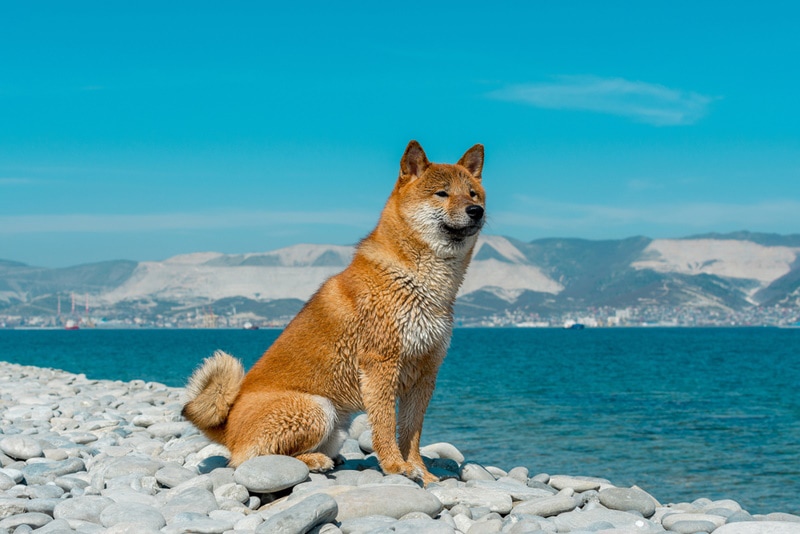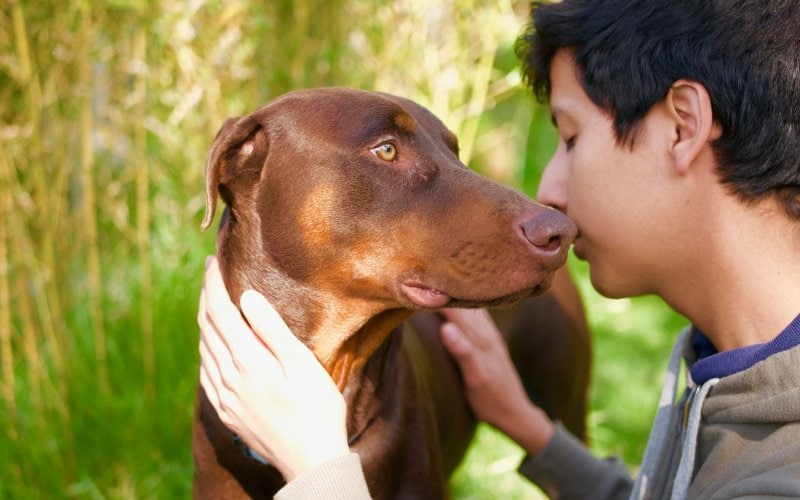4 Shiba Inu Colors: Pictures, Facts & History
By Hanh Duong
Updated on

Are you interested in Japanese dogs? If so, you’ll be fascinated to learn about the Shiba Inu, an ancient Japanese breed that’s gaining popularity in the West. They’re already the most loved breed in Japan!
These little but muscular dogs were initially bred for hunting. They have a distinctive fox-like appearance with a sleek stride and alert expression. In this article, we’ll explore the four officially recognized colors of Shiba Inu by the American Kennel Club.
How Are Shiba Inus Classified?
These small-to-medium-sized dogs are the tiniest of the six unique and distinct spitz breeds that are native to Japan. Their name, which translates to “brushwood dog,” reflects their exceptional ability to flush game.
If you’re wondering about their size, an average Shiba Inu can stand between 13.5 and 16.5 inches tall and weigh between 17 and 23 pounds. They’re also known for their impressive lifespan, with a healthy Shiba expected to live for 12 to 15 years. Also, don’t forget their signature Urajiro pattern, a white marking that adds elegance to their coat colors, which will be explained in more detail later.
The 4 Shiba Inu Colors
1. Red

These adorable pups are known for their striking red coat, which comes in shades ranging from a light tan to deep mahogany. They have been used as hunting and watchdogs by Japanese farmers for centuries and can make great companions due to their loyalty, intelligence, and bravery.
They also often have white markings on their chest and muzzle, making them even more charming. Although they originated in Japan, Red Shiba Inus have quickly gained popularity in North America since a few of them were imported to the United States in the early 1990s.
The red Shiba Inu is a stunning and highly sought-after coat color among the four different types of this breed. When you think of a Shiba Inu, the image of their striking reddish-brown color is likely the first thing that comes to mind.
The Red Shiba Inu has earned recognition from numerous kennel clubs in Europe and the United States, including FCI (Fédération Cynologique Internationale), AKC (American Kennel Club), CKC (Canadian Kennel Club), NZKC (New Zealand Kennel Club), and UKC (United Kennel Club), solidifying their status as a beloved breed worldwide.
2. Black & Tan

If you’re a fan of the Shiba Inu, then you might have come across a black and tan variation of this adorable breed. What makes them stand out is their tri-colored coat—a black-colored base with tan points and Urajiro areas. In addition, the single strand of hair from a black and tan Shiba Inu has all three colors: light cream, reddish tan, and a black tip.
The tan markings occur only between black and white areas and are restricted to the eye spots inside the ears, cheeks, legs, and tail.
After the red-colored coat, black and tan is one of the most common colors for this breed. While some people find them to resemble teddy bears, others see them as more formal-looking dogs than the red or sesame versions.
3. Cream

It’s interesting to learn that a cream Shiba Inu can appear almost white due to the Urajiro pattern that can be more difficult to see than others. This results from the dog inheriting a recessive gene from each parent, which is also why the cream coat is considered the least desirable of the four.
However, despite their uniqueness, cream-colored Shiba Inus are not very popular. In fact, the cream is considered a fault by judges at dog shows. But don’t worry; cream Shibas make excellent pets and are just as lovable and loyal as their more-traditional counterparts.
4. Sesame

Have you ever seen a red sesame Shiba Inu? Their coat is genuinely unique and can be difficult to spot. The Shiba Inu must have a foundation color of red with smooth black points on top to be classified as a true sesame color. Their coat should exhibit the Urajiro pattern and have less than 50% black pigmentation on the outer layer.
The tipping on their body and head should be light and even, with no concentration of black in any area. The sesame areas should appear at least one-half red and can even end in a distinctive V shape on the forehead, leaving the bridge and sides of the muzzle red. Eye spots and lower legs are also red, and there can even be a patch of the blaze on the throat, fore chest, or chest in addition to Urajiro.
Clearly delineated white markings are permitted but not required on the tip of the tail and in the form of socks on the forelegs to the elbow joint, and the hind legs to the knee joint.
Frequently Asked Questions (FAQ)
What Is a Urajiro Shiba Inu?
The American Kennel Club (AKC) requires a unique feature called Urajiro on all coat colors of Shiba Inus. It’s a cream-to-white ventral color that should be present in specific areas such as on the cheeks, on the sides of the muzzle, upper throat and on the underjaw, inside the ears, inside of legs, on the abdomen, and the ventral side of the tail.
What Is the Rarest Shiba Inu Color?
The answer is sesame. It’s a fascinating and complex type that requires several specific criteria to be considered sesame color. Did you also know that in a dog show, too little or too much black in the coat can result in penalties? Similarly, if the dog is missing proper leg markings and red eye patches, it can also lead to deductions.
Do Shiba Inus Change Coat Colors?
Your furry friend’s coat and markings can change over time. As your pup sheds their puppy coat, you might notice differences in their fur color. Some puppies are born with white markings on their chest and toes that will eventually fade away.
While it can take a year or two for your Shiba Inu’s final coat color to settle, it can be exciting to watch your pet grow and change. It’s not uncommon for adult Shibas to be a lighter color than their puppy coat suggests. You can take pictures of your pet at different ages and compare them to see how much they’ve changed. It’s always a good idea to microchip your furry friend—this is an effective way to prove their identity in the case of significant color changes over time.

What Kind of Coat Does a Shiba Inu Have?
Their fur is double-coated, which means it’s super thick, with a stiff, straight outer coat and a soft, dense undercoat. But all that fluffiness comes with a price—a lot of shedding. Shiba Inus has two official shedding seasons: one in the fall and another in the spring. So, get ready for some extra cleaning during those times!
Who Are Shiba Inus Best For?
Shibas are devoted and affectionate dogs that form close bonds with their owners and like taking part in household activities. However, they have a reputation for being independent and stubborn. Therefore, Shiba Inu owners should preferably be experienced and have the ability to recognize and adapt to their dog’s unique requirements.
Conclusion
While we’ve covered the coat colors recognized by the American Kennel Club for Shiba Inus, it’s important to note that you may come across pups with different shades. However, beware of breeders who try to pass off these unofficial colors as rare or unique. Often, these colors are the result of crossbreeding with other dog breeds, which isn’t necessarily a bad thing but shouldn’t be used as a reason to charge you more. Ultimately, the most critical factor is finding a reputable breeder who prioritizes the health and well-being of their pups.
Featured Image Credit: Spencer-Xu-Shutterstock














